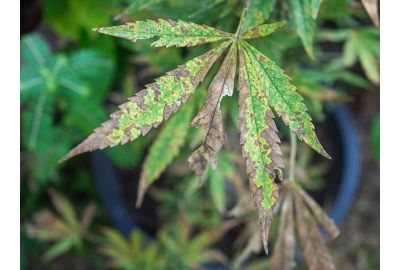Nitrogen Deficiency in Weed Plants and How to Fix it
Nitrogen (N) is essential for your cannabis plant’s growth. Any nitrogen deficiency in weed plants can critically hinder their development. Identifying and solving the problem at the onset prevents you from losing your crop.
Let’s look at the importance of the nutrient and how a lack or surplus of nitrogen in cannabis plants can seriously affect their growth. You’ll learn how to notice the early signs your plant gives you and the remedial action to take before any severe damage occurs.
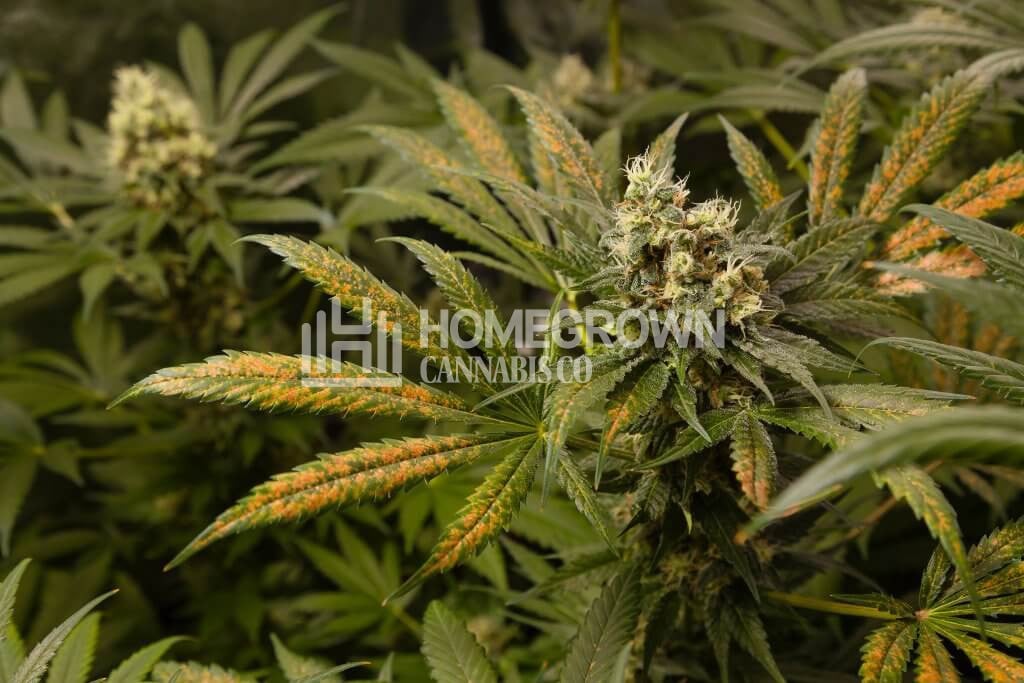
What does nitrogen do for plants?
It’s critical to understand what nitrogen does for cannabis plants, especially in the vegetative stage because, without it, there’s no growth.
Marijuana plants need nitrogen for:
- photosynthesis
- transporting amino acids
- boosting the plant’s immunity
Growers need to be aware of two major problems: nitrogen deficiency in their cannabis plants and excess of the nutrient. Although your marijuana plant needs nitrogen to thrive, it must get an adequate amount—too much or too little of it can cause issues.
Let’s take a closer look at both potentially damaging issues and how you can solve them.
What is nitrogen deficiency?
Nitrogen deficiency in your weed plant means it’s not getting the optimum amount of the nutrient to grow healthily. When there isn’t enough nitrogen for new leaves your plant will take the nutrient from the older leaves, to feed the newer ones. This causes the earlier foliage to turn yellow and wither.
To correctly diagnose cannabis nitrogen deficiency, the yellowing and wilting leaves must start at the lower part of your plant and move upwards. When you notice this symptom, you have to act quickly to prevent the problem from worsening.
Without nitrogen, your plant can’t develop cells and produce energy for its growth.
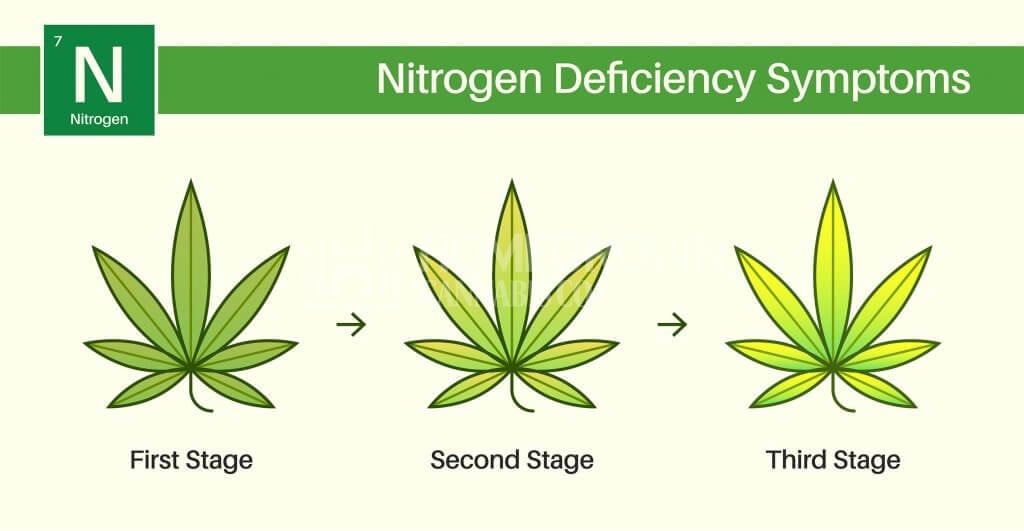
What causes nitrogen deficiency in weed plants?
As a cultivator, you need to be aware of the most common causes of nitrogen deficiency in your weed plant so you can take control early before the situation gets out of hand:
Soil type
Some soil types, such as sandy, have poor nutrient retention capacity and are prone to nitrogen leaching. Lack of moisture in the soil can also affect the root’s ability to absorb nutrients.
Overwatering
Overwatering can lead to cannabis nitrogen deficiency. Besides being caused by giving excessive water to your plant, it can also be due to heavy rains if you grow outdoors.
Poor soil aeration
With proper air content, there’s enough oxygen (O2) for the bacteria that provide your weed plant with organic nitrogen. Lack of soil aeration will cause the bacteria to use nitrogen dioxide (NO2) or nitrate (NO3).
Soil pH
Nitrogen deficiency in your weed plant can also be due to unfavorable soil acidity. The pH level of your soil should not be too high or too low. Cannabis plants prefer slightly acidic soil conditions, between 6.0–7.0.
Soil temperature
Your soil temperature affects the amount of nutrition your crop gets. At the optimum level, 70–80°F, it releases plenty of plant-ingestible nitrogen. The cooler it is, the higher the risk of marijuana nitrogen deficiency.
Soil salinity
Your plant’s ability to absorb nutrients can be adversely affected by soil salinity because of osmotic pressure and lower access to nitrogen.
High mineral levels
Increased quantities of zinc (Zn), magnesium (Mn), potassium (K), and chlorides can also cause nitrogen deficiency in cannabis plants.
Infestation and diseases
If you have weeds, they can deprive your crop of nitrogen. Pest and diseases can damage your plant’s roots and reduce nutrient intake.
Lack of organic matter
Organic matter is a natural source of nitrogen, so if your soil lacks it, your plant will have a low intake of the nutrient.
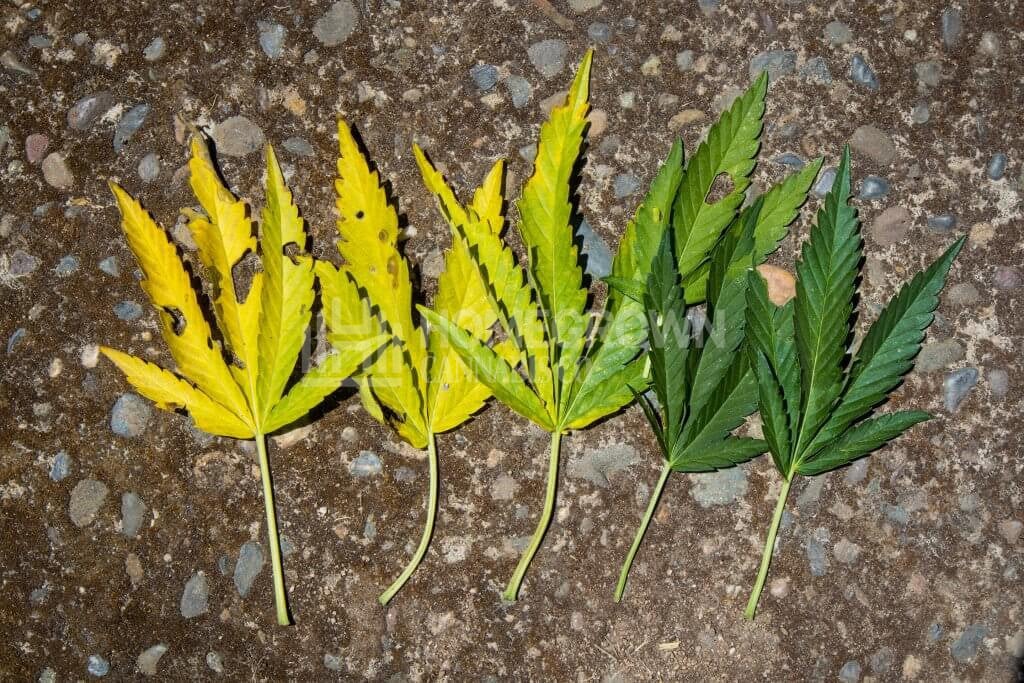
Cannabis nitrogen deficiency symptoms
Here, you’ll learn how to identify signs of marijuana nitrogen deficiency in your cannabis crop. As a cultivator, you have to be vigilant and always look out for the signals your plant gives you when it’s not feeling well.
Whenever you notice leaves looking less vibrant or yellowing, you need to investigate immediately. A change in its foliage color usually indicates a problem, although it may not necessarily be a symptom of cannabis nitrogen deficiency.
If the leaves turning yellow are at the top of your crop or are new ones, it’s probably not a case of lack of nitrogen.
Yellow foliage could be a symptom of other issues such as insufficient potassium, zinc, sulfur, iron, or magnesium, which is why you have to learn how to pinpoint that it’s a nitrogen deficiency in your weed plant.
Early signs of a lack of nitrogen typically start at the bottom of your plant. The oldest leaves at the lowest part begin yellowing first before moving upwards through the stems and branches. The chlorosis results from your plant providing newer leaves with chlorophyll by removing nitrogen from the lower, more mature foliage.
The cannabis nitrogen deficiency will cause your crop to discolor before the older leaves wither and die.
There are two stages of the problem. It’s essential that you are familiar with the signs at each phase, so you know how serious the matter is.
Early nitrogen deficiency in weed symptoms
It’s critical to detect a marijuana nitrogen deficiency problem early before it gets severe and damages your cannabis crop beyond repair. You could lose a precious plant if you don’t take prompt remedial action.
Early signs of nitrogen deficiency in weed plants
Here are common symptoms to look for:
- Older leaves at the bottom of the plant turning yellow
- Red or purple stems
- Browning foliage
- Wilting and drooping leaves
- The stunted growth rate during the vegetative phase
Late nitrogen deficiency in weed symptoms
If the problem is left undetected, the risk of plant damage or death increases.
Severe symptoms of cannabis nitrogen deficiency
It's critical to identify these late, but serious signs:
- The pale-green mature leaves become yellow and white
- The stems and newer leaves turn purplish or reddish. Vertical purple stripes appear on the stems
- Your plant accelerates through the vegetation stage into forced flowering
- Chlorosis moves upward to the top level of your plant
- Leaves curl and drop off
- You get lower yields
- Plants wither and die prematurely
How to fix nitrogen deficiency in cannabis plants?
When you’ve isolated the problem as marijuana nitrogen deficiency, it’s easy to remedy it. All you need to do is feed your plant more of the nutrient. Here are some simple ways to do it:
Use a nitrogen-rich fertilizer
Your plant needs plenty of nitrogen during the vegetative stage. If you’re already using nutrients, then you probably don’t have a cannabis nitrogen deficiency issue. If you’re not using fertilizer, it’s a quick way of adding the nutrient to your crop’s diet and helping your plant recover.
Many store-bought pre-mixed nutrients for cannabis growth contain the right ratio of nitrogen that plants need. Organic and fish-based fertilizers also usually have nitrogen-rich amines.
To avoid ending up with a cannabis nitrogen toxicity problem, be sure to start with lower than the dosage recommended by the manufacturer or risk overfeeding your plant. You can increase the dose gradually.
Add nitrogen supplements
Check if your fertilizer provides your plant with an adequate amount of nitrogen. If not, add the nutrient through regular supplements and see if your plant begins to recover. Adding a small dose of calcium and magnesium (cal-mag) can reduce the nitrogen deficiency in your weed plant by improving your plant’s nitrogen uptake.
Proper soil pH
Your marijuana plant’s ability to absorb nitrogen depends on the pH level of the soil. It loves a slightly acidic medium, so a high or low pH can cause a decreased uptake of the nutrient. If you check and maintain the optimum pH level, you can reverse the problem of nitrogen deficiency in your cannabis crop.
Use a foliar spray
Marijuana plants absorb small amounts of nutrients through the surface of their leaves, so you should consider foliar feeding to give your crop additional nitrogen. Choose a light foliar spray that’s rich with the nutrient. A seaweed or fish-based spray is rich in the nitrogen your plant needs.
Stop overwatering
You can solve marijuana nitrogen deficiency caused by excess water by ensuring that you only water your plant when it’s dry. You can check the soil by inserting a finger about two inches deep to see if there’s enough moisture.
Use the right soil
Avoid sandy soil because it doesn’t retain nitrogen, choose soil that isn’t prone to nutrient leaching. Lack of moisture in the soil can also affect the root’s ability to absorb nutrients.
You can usually solve the marijuana nitrogen deficiency problem within a week of adding the nutrient, and your plant will recover. However, you should remove the discolored foliage as the yellow leaves will wither and die.
If you don’t see any improvement or the problem continues to spread after a week or two, there may be other reasons for the chlorosis. Be sure to find out and stop the damage it’s causing.
Here’s a summary of the signs to notice and the actions to take:
| Symptom | Solution |
| Chlorosis - discoloration of the mature leaves | Stop overwatering |
| Stems turning purplish or reddish | Add fertilizer, preferably nitrate-rich ones, for faster results |
| Leaves curl and drop off | Use a foliar spray rich with nitrogen to feed the leaves |
| Stunted growth | Choose the right type of soil to minimize nutrient leaching |
What is cannabis nitrogen toxicity?
The other issue new growers can experience is cannabis nitrogen toxicity. This problem occurs when there’s an excess of the nutrient.
Seasoned cultivators speak of marijuana plants getting “The Claw” when referring to nitrogen toxicity because one of the main signs of this condition is that your plant’s leaves curl at the tips, resembling a claw.
Before you conclude that you have a problem with nitrogen toxicity in your cannabis plants, you must rule out overwatering. Some of the symptoms are similar, except that the clawing you see in the case of the former is random.
All marijuana cultivars display different signs of “The Claw,” but these are the typical symptoms to look for when determining if your plant has a marijuana nitrogen toxicity problem.
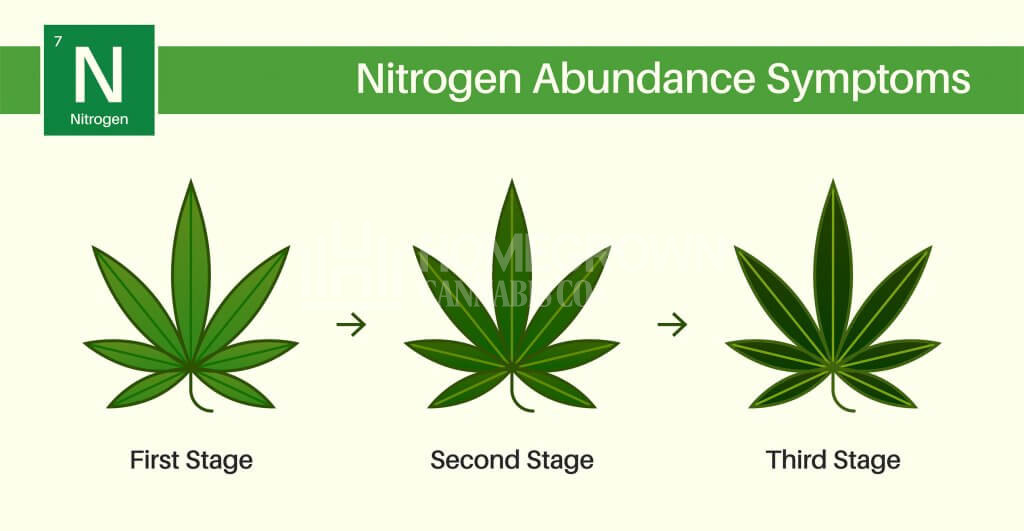
Symptoms of nitrogen toxicity
These are typical signs of excess nitrogen in your plant:
Curled leaves
One of the main signs your plant will give you when experiencing cannabis nitrogen toxicity is curled leaves. The tips will bend, resembling a claw, thus the nickname for the condition. You’ll also see something similar when plants are over-watered, but it’ll be every leaf, while the claws appear randomly in the case of excess nitrogen.
There’ll be shiny and dark green foliage when there’s too much nitrogen in your cannabis plant. The intense hue is a definite indication of the problem. These signs appear in the older leaves before showing up in the new ones.
If you don’t treat the plant, the foliage will turn yellow and brown, then wilt and die.
“Nute burn”
Another important sign of nitrogen toxicity in cannabis plants is nutrient burn, which is primarily damage due to over-fertilization. Overfeeding your plant with fertilizer can lead to an excess of nitrogen. Generally, plants will absorb everything they’re fed to the point they get sick, so growers have to regulate the amount given.
Too much nitrogen in cannabis plants can also be due to nutrient-rich soil. Over-fertilizing aggravates the problem. It’s critical to identify the issue quickly and take steps to remedy it because nute burn damage isn’t reversible.
What happens when you add too much nitrogen during flowering
There’s no cause for concern if you see your cannabis plant’s leaves yellowing towards the end of the bud-producing cycle. Nitrogen deficiency during flowering is normal as your plant requires less of the nutrient when budding.
Excess nitrogen can affect the flowering process and reduce the aroma and flavor of the buds, so a lack of the nutrient at this time is a good thing. This is the reason flowering fertilizers contain a lower ratio of nitrogen to phosphorus and potassium.
If you have too much nitrogen during flowering, you’ll notice:
- The claw, which are tips of leaves curling downwards
- Dark green foliage
- Fragile stalks and stems
Your plant will end up with a weak immune system, making it vulnerable to pest infestations.
How to fix nitrogen toxicity in weed plants?
Here’s how you can resolve a cannabis nitrogen toxicity situation:
Cut your losses
Remove leaves and buds that have been affected to prevent the problem from spreading to healthy parts of your plant.
Flush out excess nutrients
Water your plant with pH-balanced water and test the soil. Repeat until the soil nutrients are in a healthy range. The same method is used with hydroponic weed plants.
Adjust the fertilizer dose
You can also reduce nitrogen toxicity in your cannabis plants by diluting the dose prescribed by fertilizer manufacturers. Experienced growers suggest starting with half the amount and increasing it gradually.
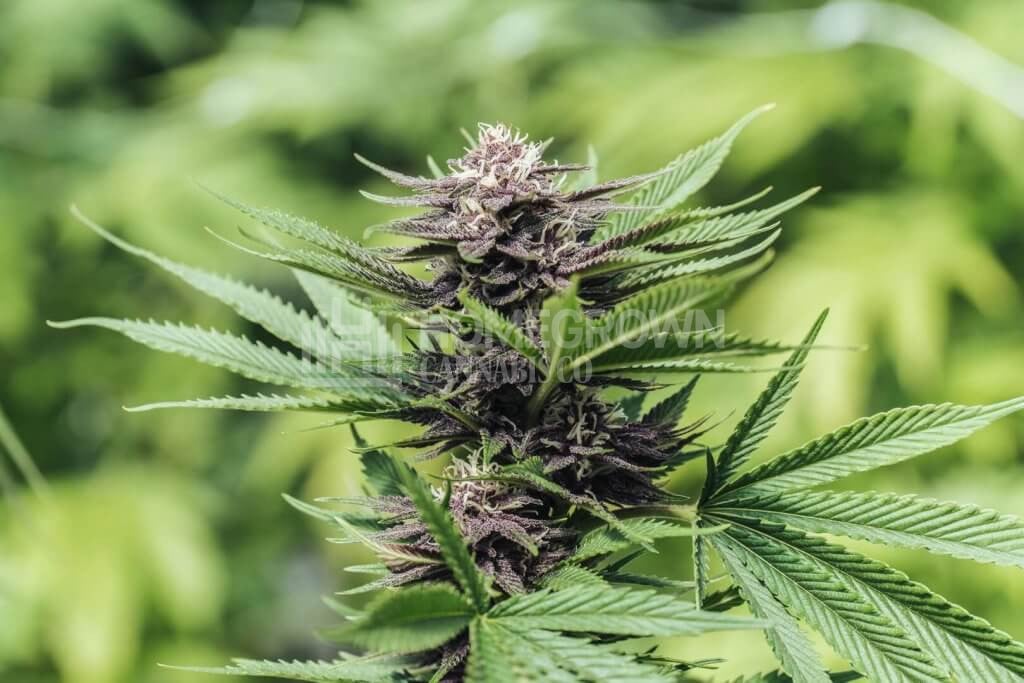
Nitrogen deficiency in weed is an easy fix
Ensuring your cannabis plant has the optimum amount of nitrogen for its healthy growth is a challenge because there are many factors that can cause your plant to have a marijuana nitrogen deficiency problem.
Now that you've learned the symptoms of the potentially damaging issue, be sure to pay close attention to your crop so you can take the suggested remedial action.
With early detection of the signs, cannabis nitrogen deficiency is an easy fix. You can get more growing information, tips, and high-quality seeds from our website.
About the author: Derek LaRose
Also known as Kronic from The Cannabis Kronicles, Derek LaRose is a young ambitious cultivator and a staple educator for indoor cultivation.
